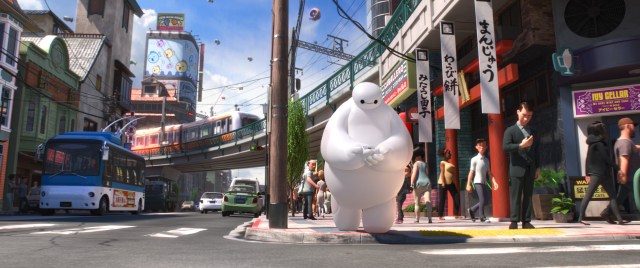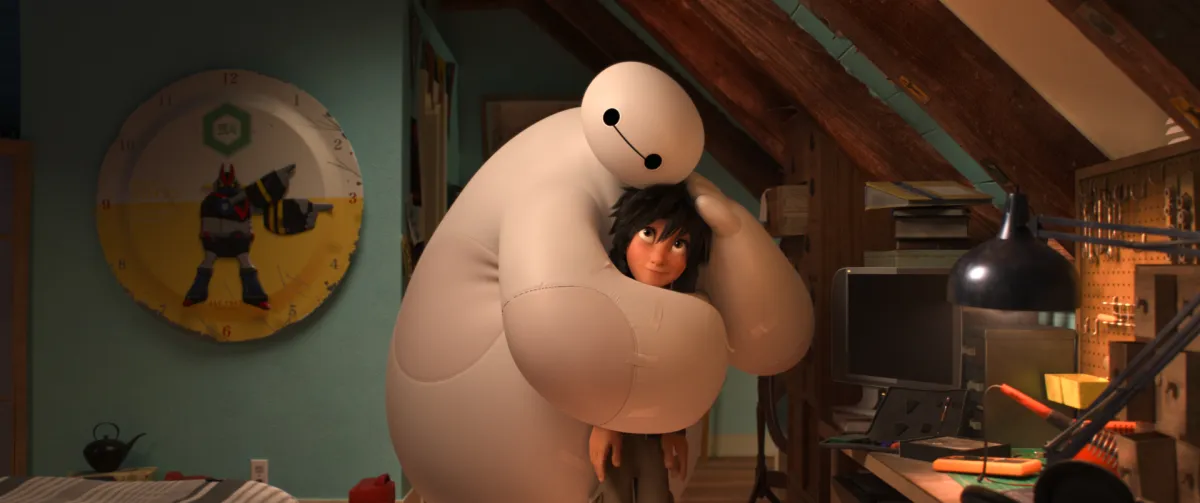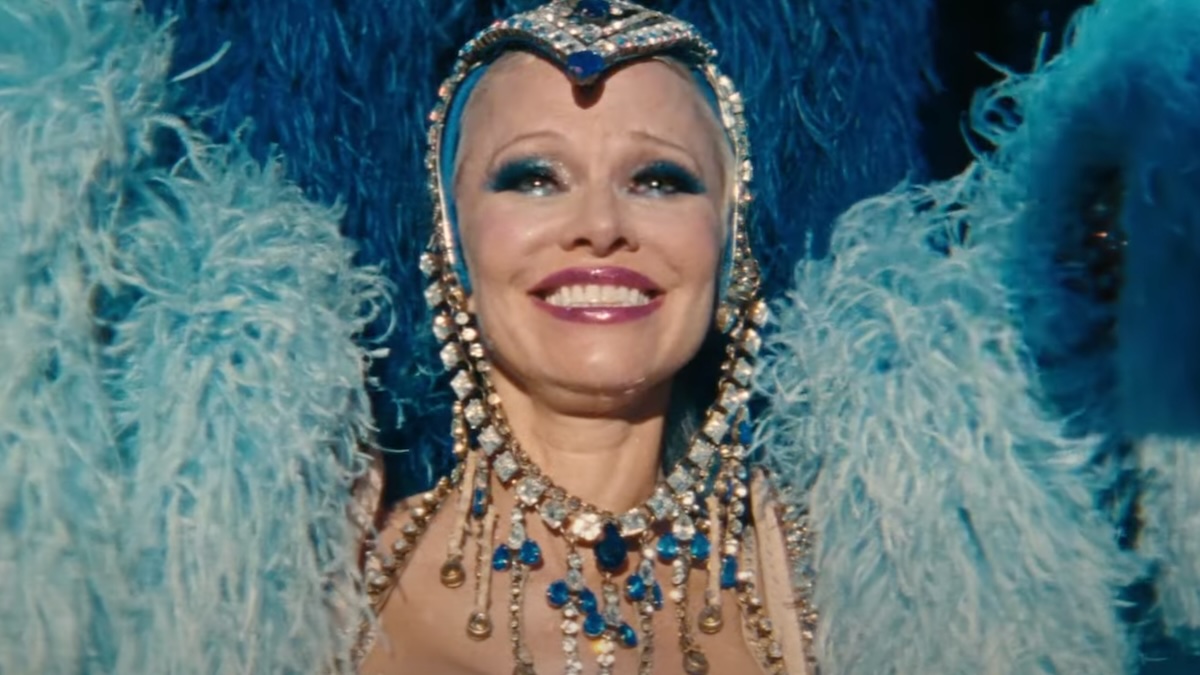While releasing two big pictures the same weekend can often be trouble at the box-office, I wouldn’t be surprised if the dual release of Interstellar and Big Hero 6 this weekend proves to be the perfect pairing for movie watchers. While Interstellar is serious, long, and rooted in reality, Big Hero 6 is funny, brisk, and playful in its fantasy. In short, Big Hero 6 is ideal counter programming for Interstellar, and the perfect antidote for those who feel heavy after spending a few hours with Nolan’s film. But regardless of whether you are choosing from one of the big movies out this week or planning a double feature, Big Hero 6 is my pick for the must see movie of the weekend.
Disney has had a difficult year in terms of providing strong family programming. Planes: Fire and Rescue was far from stellar, although a considerable improvement on the first. And Alexander and the Terrible, Horrible, No Good Very Bad Day couldn’t have picked a worse title for their reviews… headlines have never been so easy. But now we have this, an obscure Marvel property about a new super hero team, led by a boy genius named Hiro, and his marshmallow-looking robot. Baymax, the lovable robot, is – as Hiro’s brother calls him – non-threatening and huggable, created as a health care assistant. Baymax, along with Hiro’s brother’s schoolmates, are always around to make Hiro feel better.
I can’t overstate the near perfection of Baymax’s character design. Like another obscure Marvel property we met this year, he has both the literalist sensabilities of Drax and the innocence of Groot from Guardians of the Galaxy. But Baymax is also one who is at the hands of his programmers, which makes him as vulnerable as his puffy balloon body. He is, as described, instantly huggable, and parents will likely see him on christmas lists (honestly, I want a stuffed Baymax). The design of the character is simple but effective, whether in his natural state or in his special super-hero suit. But is also given smart dialogue and character consistency, and a perfect bit of voice casting with 30 Rock’s Scott Adsit, the last person I would have cast as a robot.
Hiro is also well-voiced by Ryan Potter, ideal for playing our 14-year-old genius protagonist. It is a smart idea to write Hiro as a teenage genius, not only because it provides an explanation for how he could create and know as much about robotics as he does; but also because it gives the character a bit of internal conflict. He is smarter than even his older brother, but not yet mature enough to make big decisions. He uses his intelligence at times in destructive ways which would be completely understandable for a teenager, no matter their IQ. And it also allows for the age gap between Hiro and his team of college students who help him in his mission to bring down the man in the mask.
The man in the mask uses Hiro’s invention of micro-bots, tiny interconnected pieces which can become a single robotic unit, for nefarious purposes. He is, in basic terms, our supervillain, a threatening image reminiscent of two other Marvel villains: Red Skull and Dr. Octopus. As with Baymax, his character design is rather brilliant in its simplicity. The moving parts at times almost look liquid (like Spiderman’s Venom), but upon closer inspection, are always moving just enough to show the mechanics involved. And combined organic/mechanical look makes the robotics seem all the more threatening, particularly as they surround and trap characters.

Combine that black mass of robotics with the bright and poppy look of the film, and you have the vibrant world of San Fransokyo, a richer world than the reminiscent world of Speed Racer (although comparisons to the cartoon and film can easily be made). The action scenes in Big Hero 6 are all phenomenal, especially a car chase and flying sequence, with special consideration given to the rather ingenious lighting design. And all the characters are designed to have a distinct, endearing look despite Disney Animation’s odd sameness to all their characters’ faces. Any one of these characters could be given different clothing and been placed in Frozen.
But I’m willing to overlook the facial sameness, particularly because of the expressiveness of the characters’ eyes, and partially because the characters work so well as written. After what seems like years of complaining about Marvel’s unwillingness to diversify, having the character of Hiro and his brother, Tadashi, clearly be Asian-Americans, is refreshing, as is the the diversity of characters surrounding them. We have their aunt voiced by Maya Rudolph; friend Fred voiced by TJ Miller (fully recovered from his appearance in Transformers: Age of Extinction); laser inventor Wasabi voiced by Damon Waynes; tough GoGo Tomago voiced by Jamie Chung; and optimistic mad scientist Honey Lemon voiced by Genesis Rodriquez. And there isn’t a voice talent who fails to commit fully to their role.
As a movie for children, it has a lot going for it. It fully embraces diversity and gender equality without that the defining elements of their characters. The movie also happens to be a love letter to science, and how cool it can be to study it. All these characters are students at a school for technology, where they invent wondrous new projects and engineer major advancements. Hiro is as good, or better, than all of the students, but doesn’t yet understand the idea that science comes with the obligation to use that knowledge to better the world. And of course, there are those damn emotions.
Baymax’s obligation to Hiro comes from emotional pain (the nature of which I won’t spoil here), and the directors don’t shy away from showing the destructiveness of that pain in a way which could be truly meaningful to children. The idea that coping with pain is a long process that requires time is hard, but vital lesson to learn. But it couldn’t be done in a sweeter way then in one very special scene in Big Hero 6. And yes, I cried; but so did everyone else in the theater.
Big Hero 6 is not going to be a movie for all little kids, despite being a cartoon. It’s appeal will be a little older than Frozen, primarily because of the heavier emotional topics it is willing to tackle, and some of the intensity of the action. But kids used to superhero cartoons should be fine, and there is nothing more intense in this film than in Pixar’s The Incredibles. I saw the movie in a theater made up entirely of adults, and the lack of R-rated humor did nothing to prevent them from fully investing. Even if you don’t have kids to take, Big Hero 6 is well worth seeing if you’re looking for that fun, feel-good movie this season.
Lesley Coffin is a New York transplant from the midwest. She is the New York-based writer/podcast editor for Filmoria and film contributor at The Interrobang. When not doing that, she’s writing books on classic Hollywood, including Lew Ayres: Hollywood’s Conscientious Objector and her new book Hitchcock’s Stars: Alfred Hitchcock and the Hollywood Studio System.
Are you following The Mary Sue on Twitter, Facebook, Tumblr, Pinterest, & Google +?









Published: Nov 7, 2014 02:24 pm